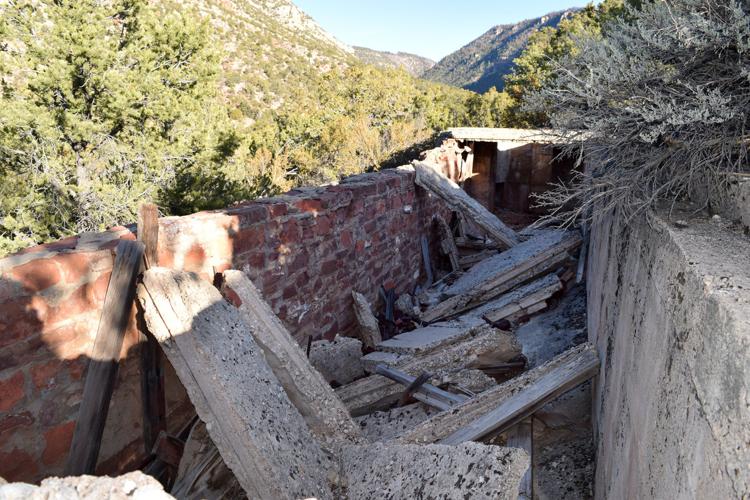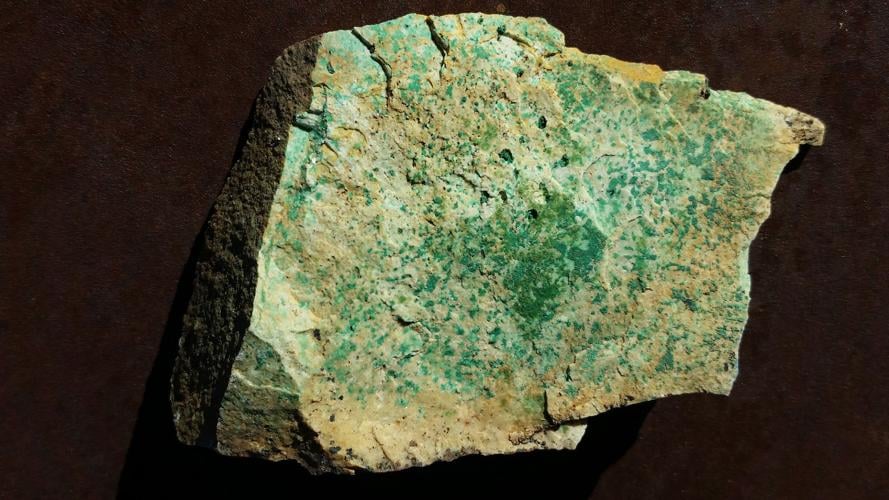Ryan is both one of Arizona’s frontier mining sites and one of its least known, seldom written about or visited.
Exploration of the Warm Springs Canyon area north of Buckskin Mountain near Jacob Lake in Coconino County began in the 1890s.
Prospectors identified limonite-stained cherty sandstone fragments on the surface, indicating veins of copper mineralization around Lamb’s Lake, later known as the Petoskey Claims.
Local geology included copper ore bodies distributed along northeast-southwest trending fractures occurring in country rock composed of Kaibab limestone, calcareous sandstone, and chert. Many of these are shallow and can be mined in open cuts. Copper carbonates azurite and malachite are primary, with some chalcocite, bornite, cuprite and chrysocolla.
Early exploitation of these deposits was by pick, shovel and blasting powder.
Additional mining ventures followed by Aquilla Nebeker, from Salt Lake City, and a man named Ryan. Both were the original operators of the Coconino or Coconino city mine and townsite around 1900.
Near the mouth of Warm Springs Canyon, 23 miles south of Fredonia on Forest Route 22 (Ryan Road), the site was said to rival that of the nearby Petoskey Claims seven miles east.
Nebeker sold his interest in the mine for $40,000 to Ryan, who christened the mining camp after himself. One source claims that Ryan was the father of the famous late 19th century prize fighter Paddy Ryan.
Mining was conducted on multiple claims northeast of Warm Springs Canyon around 1901. The Coconino Copper Co. sent small shipments of ore to a reverberatory furnace at Ryan along a road connecting Warm Springs Canyon to Jacob Lake.
The company erected housing at Ryan for its employees and a post office operated onsite for six months in 1902. The company also oversaw the smelter, charcoal furnaces and leaching plant.
Water for both the smelter and the camp was supplied by a wooden pipeline from Big Springs 7 miles south. The high silica content of the ore and instability of the copper compounds hindered production.
Charles Dedrick was the mine superintendent of the leaching plant, leased by the Esmeralda Precipitation Co., which consisted of precipitation of gas pressure in a collection of tanks containing steam coils and sulfur burners with sulfur supplied from Beaver, Utah.
The smelter was operated by C. Timmons, superintendent of the Kaibab Smelting Co.
The Buckskin Mountain Copper Co. acquired the property in 1907. It also attempted to gain a profit leaching the ore and locating additional claims.
Only a few tons were shipped by wagon from Warm Springs Canyon to Marysvale, Utah, a southern terminus of the Denver & Rio Grande Western Railroad branch line, and on to the Garfield smelter near Salt Lake City before operations ceased in 1916.
Intermittent attempts to mine the area occurred during the ensuing decades, coupled with extensive stock promotion. The St. Anthony Copper Co., formed in 1928, mined the Mackin Claims northwest of Jacob Lake.
A railroad was built from Buck Ridge down Warm Springs Canyon to the newly erected 100-ton blast furnace at Ryan. An aerial tramway was also attempted, yet abandoned, probably due to economics and a fire that destroyed the furnace the following year.
One-thousand tons of 8% copper ore were shipped to the Garfield smelter by truck and rail.
During World War II, the U.S. government halted gold mining operations nationwide as nonessential to the war effort, which reduced the usual source of siliceous flux from gold mines needed by copper smelters.
The U.S. Geological Survey determined sandstone copper-bearing areas in Northern Arizona, including the Warm Springs and Jacob Lake Mining districts could be mined as an emergency source of copper-bearing siliceous flux as dictated by high wartime copper prices.
The Apex Mining Co. renewed development of the Mackin and Petoskey (Lamb’s Lake) claims.
By 1944, V.M. Ryan (possibly related to the original investor at the Ryan Mine) and S. B. Atherley subleased both claims, extracting over 9,000 tons of ore by use of gasoline-powered shovels, including some gold and silver. The conclusion of World War II saw a decline in copper prices combined with rising costs of ore transport and inclement winter weather. These factors reduced the profitability and development of the mines in the Kaibab vicinity, with eventual reversion to the Forest Service by the 1970s.
Overall the Warm Springs and Jacob Lake Mining districts produced over four million pounds of copper, making their marks in the region’s mining history.
The remnants at Ryan testify to the fortitude and economic prowess of the local population residing on the Arizona Strip.










